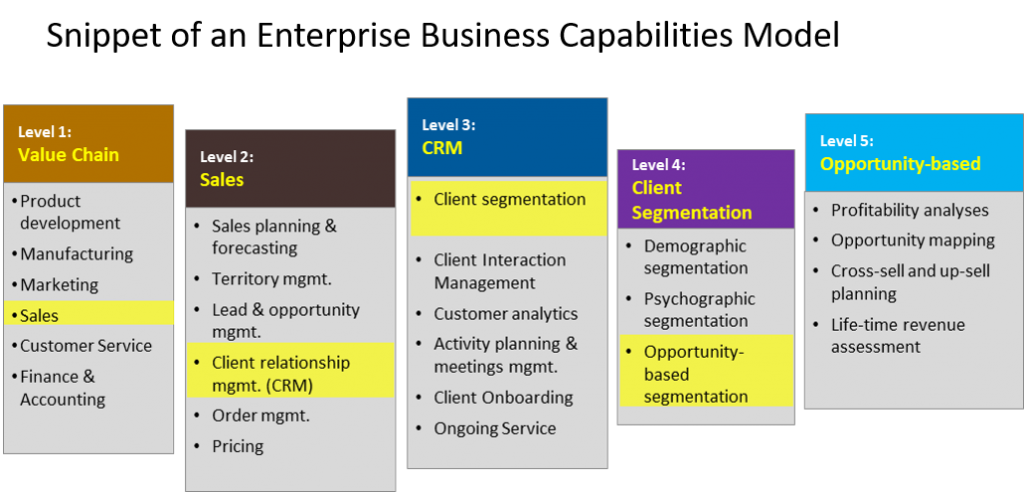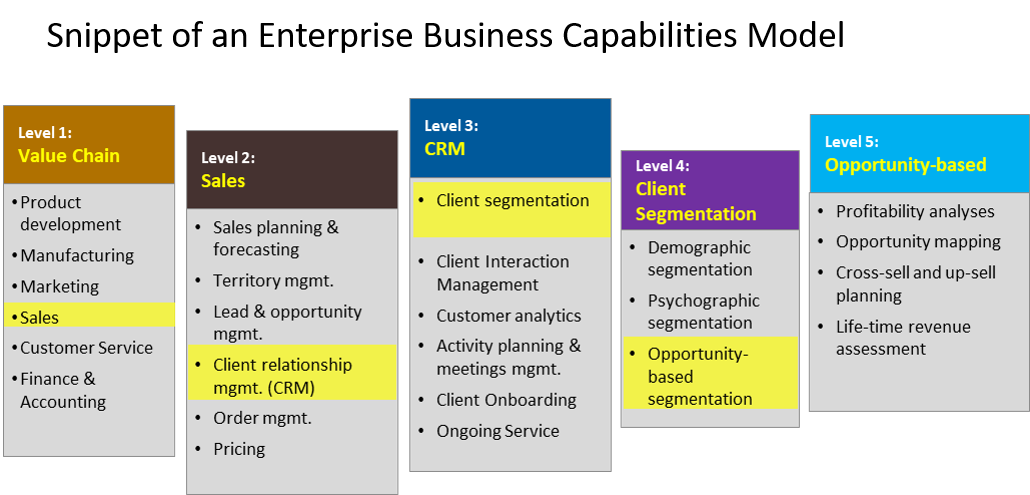CRM Capabilities help guide CRM transformation
By: Ciopages Staff Writer
Updated on: Feb 25, 2023

The emergence of social, mobile, cloud and analytics are the drivers for a customer-centric digital transformation of the customer relationship management function. CRM capabilities model (or customer relationship management capabilities map) is an essential tool for understanding what CRM function does and can do and then be able to identify new capabilities as well as enhancement opportunities within the existing capabilities. CRM Capabilities
What is a CRM Capabilities Model?
A CRM capability is an abstraction of the underlying functionality and process and captures what CRM does and can do. A capability is a business architecture term, and a CRM capabilities model is an integral part of the business architecture deliverables.
A CRM capability is a foundational building block, and it establishes a common language between business and IT. Instead of focusing on systems or processes, which are volatile and transient, leveraging CRM business capabilities will help in understanding the current state and envisioning the future state and crafting a capability-centric CRM transformation roadmap.
What are some sample CRM Capabilities?
CRM or customer relationship management is a broad and expansive term, and different companies define the boundaries differently.
Furthermore, if a company has created an enterprise business capabilities map, CRM may be a lower level capability. For example, a snippet of an enterprise business capabilities model may look something like the following:

As you can see CRM is a Level 2 capability. While the level itself may not matter, a robust decomposition of granular CRM capabilities is of paramount importance. However, in some companies, if out of sight is out of mind, elevating the CRM function to a higher level may be appropriate. For example, if enabling omnichannel and enhancing customer experience is the most strategic goal of the enterprise, elevating CRM to a level 1 capability may make sense. Of course, this is optics and sometimes optics matter.
On the other hand, if we took a slightly expanded view of the CRM capabilities and if we were creating a standalone capabilities map to power an impending CRM transformation, here is what we might come up with. (It should be clear by now that the CRM capabilities are not set in stone with regards to position and level. Each enterprise may decompose the CRM capabilities differently reflecting the norms in the sector/industry, geography, and the company itself.
Example CRM Capabilities Model Decomposition – Level 1:
- Client segmentation
- Client Interaction Management
- Activity planning & meetings mgmt.
- Client Onboarding
- Ongoing Service
- Customer analytics
Then each of these can be decomposed to a further level of granularity. How deep you go depends on the specific purpose of the capabilities will be used. Furthermore, the CRM business capabilities model components may be different for each company, based on the industry, the business model, and the sales and service model.
For example, the CRM business capabilities map between a B2B company will vary from the core CRM capabilities of a B2B company, and indeed a B2B2C company may be a hybrid of the other two.
In the sample CRM capabilities model we are using, if we take the “Client Segmentation” capability, it now decomposes further into:
- Demographic segmentation
- Psychographic segmentation
- Opportunity-based segmentation
And the “Opportunity-based Segmentation” CRM capability drills down into:
- Profitability Analysis
- Opportunity mapping
- Cross-sell and up-sell planning
- Lifetime revenue assessment
What is the difference between a CRM Capability, Competence, Process, and System?
There is quite a bit of confusion amongst practitioners about what is a capability and what is not and also what is the difference between a CRM capability, CRM competence, CRM Process, and a CRM System. Let’s walk through a simple example to grasp these concepts, which are all different, even though they are related.
“Dispute Management” is a CRM business capability.
“Dispute Submission” is one of the CRM processes.
“Dispute resolution” may be a competency of a group of people in the company.
“Dispute Resolution Policy” is a business rule set or an SOP (Standard Operating Procedure.)
“ZenDesk,” for example, is the case management and customer support software. (Or any other myriad software solutions.)
Seven reasons your company needs a CRM Capabilities Model:
- Hyper-competition, rising customer expectations, and digital technologies are putting more demands on the CRM function. So, to succeed in this era of mega shifts, a CRM business capabilities map will help in getting your arms around what CRM does and have a structural basis to deal with change.
- A CRM capabilities model can help in translating the CRM strategy into action – at the process, people, and technology level.
- CRM is the epicenter of the customer-centric revolution. Having a detailed understanding of all capabilities and an assessment and prioritization can help in securing funding for the projects.
- We are in the era of a real-time enterprise. Knowing what CRM capabilities and Value Streams need to be real time or near real time will allow adequate technology enablement and process improvements.
- If the business and technology teams do not speak a common language, a CRM business capability map can be the common lingua franca bridging the communication gap.
- CRM transformation projects without a capability model as a foundation tend to veer toward a bunch of projects with a disparate set of requirements. A capability-based transformation roadmap helps provide the guard rails and guideposts for the implementation.
- A CRM capability model helps in conducting a capability-based vendor evaluation for the CRM functions.
Value and Use Cases of CRM Capabilities Matrix:
So, how do you use the CRM capabilities in your CRM transformation journey?
- CRM capabilities matrix is an abstraction of the underlying features and functionality desired by the business. Relying on capabilities rather than software feature functions can help in mitigating a siloed view of the needs.
- System-To-Capability footprint analysis of CRM capabilities to the underlying systems/software provides an understanding of which system supports what capability and the fragmentation or monolithic nature of the functional coverage.
- The CRM capability map can be a basis to evaluate vendor offerings as they offer a better proxy to assess the functionality, rather than deep-in-the-weeds requirements.
- The list of capabilities can be used to influence the modular and granularity of the IT Services (SOA/REST et al.) that orchestrate the capability functionality.
- The future state evolution of the CRM capabilities can be envisioned with capability-centric requirements roadmap.
If you wish to jumpstart the CRM capabilities mapping exercise, consider a ready-to-customize CRM business capabilities model.
If you need professional services to help customize or to custom build a CRM capabilities model, please contact our Advisory Services team.
To learn how to build, manage and harness business capabilities mapping and business architecture, please consider Capstera’s Business Capabilities Mapping software.